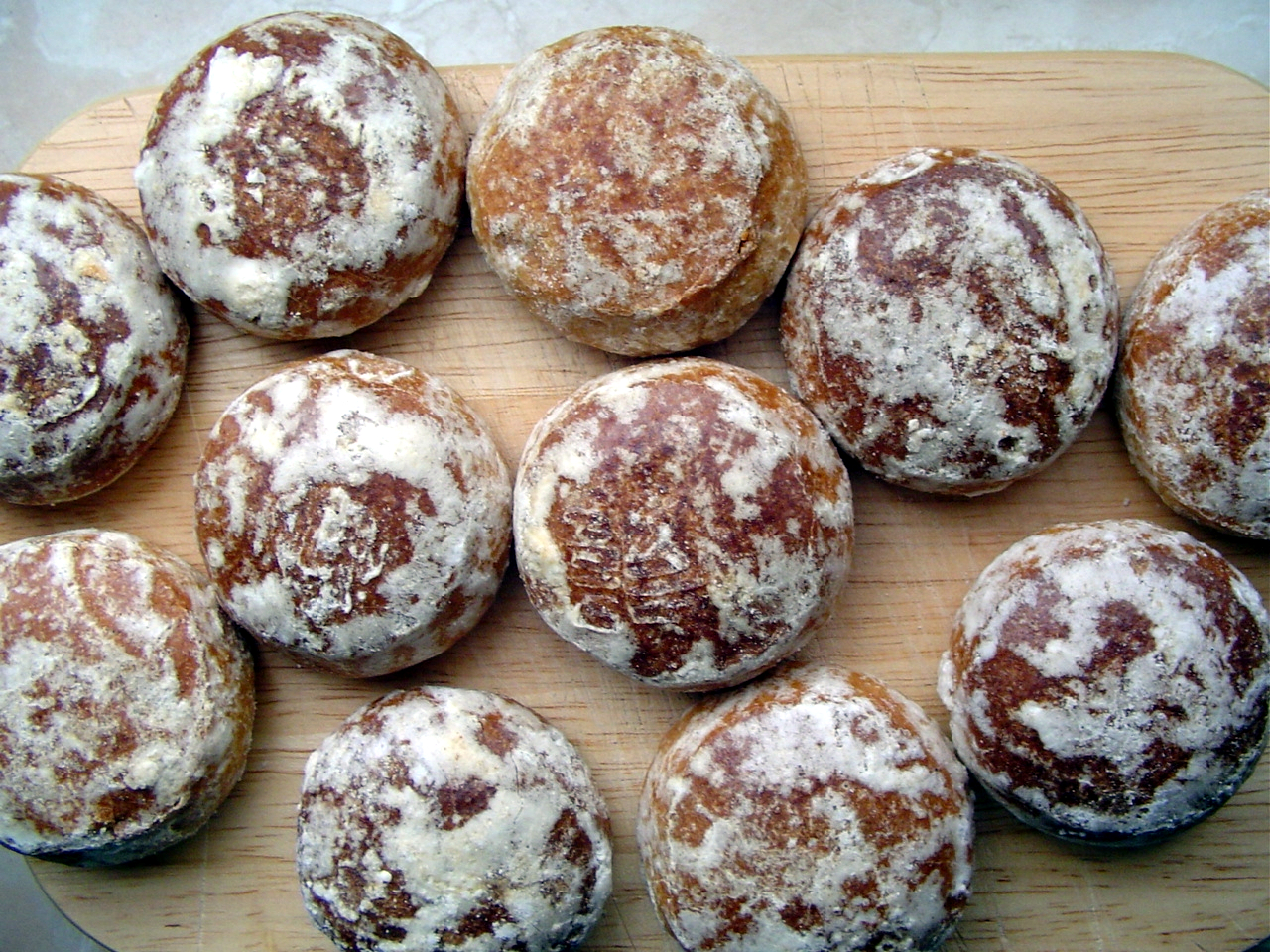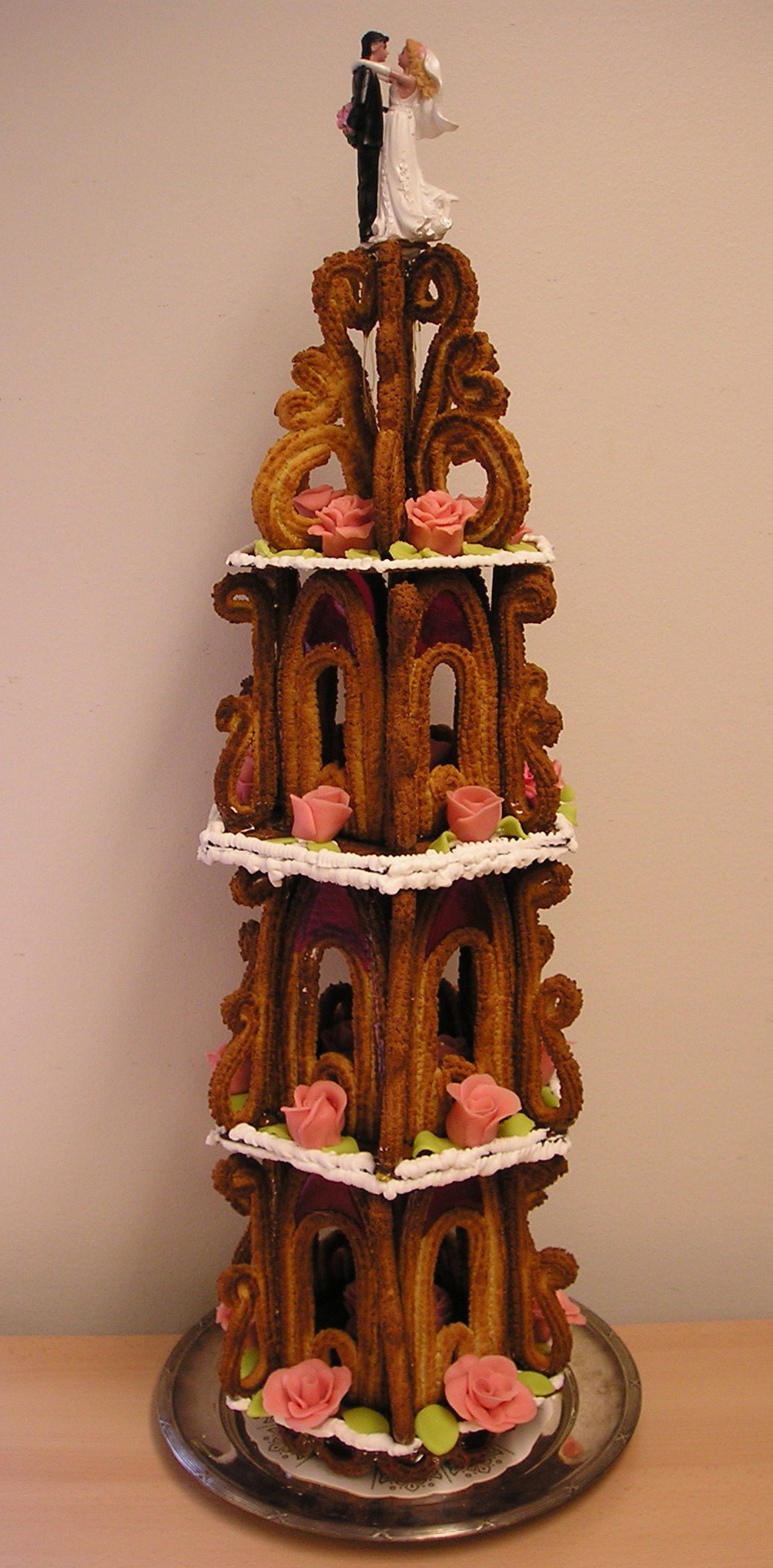|
Russian Desserts
This is a list of Russian desserts. Russian cuisine is a collection of the different cooking traditions of the Russian people. The cuisine is diverse, as Russia is by area the largest country in the world. Russian cuisine derives its varied character from the vast and multi-cultural expanse of Russia. Russian desserts * Blini (blintz) * Çäkçäk, Chak-Chak * Charlotte (cake), Charlotte * Chocolate-covered prune * Curd snack * Kogel mogel, Gogol mogol (kogel mogel) * Angel wings, Khvorost (angel wings) * Guryev porridge * Hematogen * Kissel * Kulich (bread), Kulich * Kutia * Medovik (a layered honey cake) * Mille-feuille, Napoleon (mille-feuille) * Oladyi * Paskha * Pastila (a traditional Russian fruit confectionery) * Pirog * Pirozhki * Pączki, Ponchiki or Pyshka * Pryanik ** Tula pryanik ** Vyazma pryanik * Ptasie mleczko, Ptichye moloko ("bird's milk") * Halva#Sunflower, Sunflower Halva * Sushki * Syrniki * Torpedo dessert, Trubochka (torpedo dessert) * Varenye * Vatrushka ... [...More Info...] [...Related Items...] OR: [Wikipedia] [Google] [Baidu] |
Kutia
Kutia or kutya ( ; ; ) is a ceremonial grain dish with sweet gravy traditionally served mostly by Eastern Orthodox Christians and some Catholicism, Catholic Christians predominantly in Belarusian cuisine, Belarus, Russian cuisine, Russia, Ukrainian cuisine, Ukraine, but also in parts of Lithuania and Poland during the Christmas–Baptism of Jesus, Feast of Jordan holiday season or as part of a funeral feast. The word with a descriptor is also used to describe the eves of Christmas, New Year, and Feast of Jordan days. Etymology The word ''kutia'' is a borrowing from the Greek language ('bean') or ('grain'). In Ukraine In Ukraine kutіa is one of the two essential ritual dishes at the twelve-dish Christmas Eve supper, Ukrainian Christmas Eve supper (also known as ''Svyata vecherya''). The ritual significance of kutia, as well as uzvar, is quite ancient. Ukrainian ethnographer Fedir Vovk traces the origins of these dishes to the Neolithic era. Before dinner, the kutia is plac ... [...More Info...] [...Related Items...] OR: [Wikipedia] [Google] [Baidu] |
Vyazma Pryanik
Vyazma pryanik () is a type of Russian pryanik from the city of Vyazma. History In the 19th century, eight gingerbread factories operated in Vyazma. In 1913, during the celebration of the 300th anniversary of the Romanov dynasty, the merchants from Vyazma gave Nicholai II a giant Vyazma pryanik weighing 16 kilograms (one pood). In literature The pryanik is mentioned in ''The History of a Town'' by Saltykov-Shchedrin, Chekhov's ''The Steppe'' and other works of Russian writers. Alexander Pushkin said: "Moscow is famous for its brides, like Vyazma for its pryaniks". See also * Tula pryanik Tula pryanik (, ''tulskiy pryanik'') is a famous type of imprinted Russian pryanik from the city of Tula, Russia, Tula. Usually, Tula pryanik looks like a rectangular tile or a flat figure. Making stamped pryanik is considered an art form. The imp ... References Russian Regional Food Specialties Russian desserts Russian inventions Confectionery National dishes {{Russia-cui ... [...More Info...] [...Related Items...] OR: [Wikipedia] [Google] [Baidu] |
Tula Pryanik
Tula pryanik (, ''tulskiy pryanik'') is a famous type of imprinted Russian pryanik from the city of Tula, Russia, Tula. Usually, Tula pryanik looks like a rectangular tile or a flat figure. Making stamped pryanik is considered an art form. The imprints could include different patterns, symbols, images of the Tula Kremlin, names, congratulations. The cooking of the Tula pryanik starts with preparation of the dough. The dough is made from rye flour, honey, eggs, water and spices. Next the dough is cut into pieces and rolled out. Each piece is placed on a special with a carved pattern to give the dough its intended form. The first layer of the dough is covered with a second one with a filling in between. To make the two layers stay in place the edges are pressed together. Then the cake is turned over so that the stamped image is on top and the surface is glazed with sugar syrup. The syrup covers the picture to make it more visible after baking. Historically, each carved board is use ... [...More Info...] [...Related Items...] OR: [Wikipedia] [Google] [Baidu] |
Pryanik
Pryanik ( , , ; Czech language, Czech and Slovak language, Slovak: ''perník''; ; ) refers to a range of traditional sweet-baked goods in Russia, Ukraine, Belarus and some neighboring countries such as in Poland () and Lithuania (). It is also a popular Czech and Slovak sweet. Traditionally, pryaniks are made from flour and honey. While some Russian-English dictionaries translate pryanik as ''gingerbread'', ginger is an optional pryanik ingredient, unlike honey. Sugar is often used instead of honey in industrial pryaniki production and modern home-cooking. Related to pryanik is ''kovrizhka'' (коврижка), known in western countries as a "fudge", sweet bread with similar ingredients. The word ''pryanik'' is from Old East Slavic ''пьпьрянъ'', an adjective from Old East Slavic ''пьпьрь'' 'pepper', which makes it etymologically similar or related to German Lebkuchen, Pfefferkuchen. In Germany, ginger was added to Christmas or Easter cookies – this is how the f ... [...More Info...] [...Related Items...] OR: [Wikipedia] [Google] [Baidu] |
Pyshka
Pyshka or ponchik (, pl. ''pyshki'' пышки; пончик, pl. ''ponchiki'' пончики) is a Russian variety of doughnut. Types Pyshki are either ring-shaped or without a hole. File:Пышки.jpg, Pyshki without a hole, Novosibirsk pyshki cafe Regional name variations In Saint Petersburg and Novosibirsk Novosibirsk is the largest city and administrative centre of Novosibirsk Oblast and the Siberian Federal District in Russia. As of the 2021 Russian census, 2021 census, it had a population of 1,633,595, making it the most populous city in Siber ..., the dish is called "pyshka" and the cafe is called "pyshechnaya". In Moscow, it is called "ponchik", the doughnut eatery is called "ponchikovaya". File:Donut Eatery SPB.jpg, Pyshechnaya, Bolshaya Konushennaya Street, Saint Petersburg, founded in the 1960s File:Пышечная, Новосибирск.jpg, Novosibirsk Pyshechnaya, Leninsky City District, opened in the mid-twentieth century References External links S ... [...More Info...] [...Related Items...] OR: [Wikipedia] [Google] [Baidu] |
Pączki
(; : , ; ; Old Polish and ) are filled doughnuts found in Polish cuisine. Description A ''pączek'' is a deep-fried piece of dough shaped into a flattened ball and filled with confiture or other sweet filling. ''Pączki'' are usually covered with powdered sugar, icing, glaze, or bits of dried orange zest. A small amount of grain alcohol (traditionally rectified spirit) is added to the dough before cooking; as it evaporates, it prevents the absorption of oil deep into the dough. ''Pączki'' are commonly thought of as fluffy but somewhat collapsed, with a bright stripe around them; these features are seen as evidence that the dough was fried in fresh oil. Although they look like German berliners ( bismarcks in North America) or jelly doughnuts, ''pączki'' are made from especially rich dough containing eggs, fats, sugar, yeast, and sometimes milk. They feature a variety of fruit and creme fillings and can be glazed, or covered with granulated or powdered sugar. '' ... [...More Info...] [...Related Items...] OR: [Wikipedia] [Google] [Baidu] |
Pirozhki
Pirozhki (, ; , ) are Russian baked or fried yeast-leavened boat-shaped buns with a variety of fillings. Pirozhki are a popular street food and comfort food. They are also popular in other countries. The word ''pirozhki'' is a diminutive of '' pirog'', the Russian name for pie. Terminology The stress in is on the last syllable: . ( rus, пирожо́к, r=pirožók, p=pʲɪrɐˈʐok, a=Ru-пирожок.ogg, singular) is the diminutive form of Russian '' pirog'', which means a full-sized pie. The word is derived from ''pir'', meaning "feast". Pirozhki are not to be confused with the Polish pierogi (a cognate term), which are called or ''pyrohy'' in Ukrainian and Doukhoborese, and ''vareniki'' in Russian. Variations A typical pirozhok is boat- or rarely crescent-shaped, made of yeast-leavened dough, with filling completely enclosed. Similar Russian pastries ( pirogs) of other shapes include coulibiac, kalitka, rasstegai, and vatrushka. Pirozhki are usually hand-siz ... [...More Info...] [...Related Items...] OR: [Wikipedia] [Google] [Baidu] |
Pirog
Pirog ( rus, пиро́г, p=pʲɪˈrok, a=Ru-пирог.ogg, links=yes; , , ; ; ; , ; , ; ; ) is a baked case of dough with either sweet or savory filling.Darra Goldstein. ''A Taste of Russia: A Cookbook of Russian Hospitality'', "Russian pies", p.54. Russian Information Service, 1999, Вильям Похлебкин. ''Кулинарный словарь''Пироги Москва: Центрполиграф, 2007, ( William Pokhlyobkin. ''The Culinary Dictionary'', "Pirogi". Moscow: Centrpoligraph, 2007; in Russian) The dish is common in Eastern European cuisines. The name is derived from the ancient Proto-Slavic word ''pir'', meaning "banquet" or " festivity".Вильям Похлебкин. ''Большая энциклопедия кулинарного искусства''Пироги русские Москва: Центрполиграф, 2010, ( William Pokhlyobkin. ''The Great Encyclopedia of Culinary Art'', "Russian pirogi". Moscow: Centrpoligraph, 2010; in ... [...More Info...] [...Related Items...] OR: [Wikipedia] [Google] [Baidu] |
Confectionery
Confectionery is the Art (skill), art of making confections, or sweet foods. Confections are items that are rich in sugar and carbohydrates, although exact definitions are difficult. In general, however, confections are divided into two broad and somewhat overlapping categories: baker's confections and sugar confections. Baker's confectionery, also called flour confections, includes principally sweet pastries, cakes, and similar Baking, baked goods. Baker's confectionery excludes everyday Bread, breads, and thus is a subset of products produced by a baker. Sugar confectionery includes candies (also called ''sweets'', short for ''sweetmeats'', in many English-speaking countries), candied nuts, chocolates, chewing gum, bubble gum, pastillage, and other confections that are made primarily of sugar. In some cases, chocolate confections (confections made of chocolate) are treated as a separate category, as are sugar-free versions of sugar confections. The words ''candy'' (Canada ... [...More Info...] [...Related Items...] OR: [Wikipedia] [Google] [Baidu] |
Pastila
__NOTOC__ Pastila ( ) is a traditional Russian fruit confectionery ('' pâte de fruits''). It has been described as "small squares of pressed fruit paste" and "light, airy puffs with a delicate apple flavor". In Imperial Russia, the "small jellied sweetmeats" were served for tea "with a white foamy top, a bit like marshmallow, but tasting of pure fruit". The first mentions of pastila in Russian written sources date back to the 16th century.М. Р. Фасмер. ''Этимологический словарь русского языка''. Прогресс, 1964—1973Пастила(Max Vasmer, ''Etymological dictionary of the Russian language''). The name is probably a loanword from or ''pastiglia'', or from the cognate which in turn comes from (a loaf or pie, cf. pastilla). In the 19th century, pastila was made from sourish Russian apples such as Antonovka or mashed Northern berries (lingonberry, rowan, currants) sweetened with honey or sugar and lightened with egg whites. ... [...More Info...] [...Related Items...] OR: [Wikipedia] [Google] [Baidu] |
Paskha
Paskha (also spelled ''pascha'', or ''pasha''; ; ; "Easter") is an East Slavic festive dish made in Eastern Orthodox countries which consists of food that is forbidden during the fast of Great Lent. It is made during Holy Week and then brought to Church on Great Saturday to be blessed after the Paschal Vigil. The name of the dish comes from Pascha, the Eastern Orthodox celebration of Easter. Besides Russia, Ukraine, etc. Pasha is also often served in Finland where it is common among the Orthodox Karelian minority. Cheese paskha is a traditional Easter dish made from tvorog (like cottage cheese, ), which is white, symbolizing the purity of Christ, the Paschal Lamb, and the joy of the Resurrection. It is formed in a mold, traditionally in the shape of a truncated pyramid which symbolizes the first Passover in Egypt, a nod to Christianity's early Jewish beginnings and a reminder that the Last Supper of Jesus was a Passover Seder. Others believe the pyramid is a symbol of th ... [...More Info...] [...Related Items...] OR: [Wikipedia] [Google] [Baidu] |





